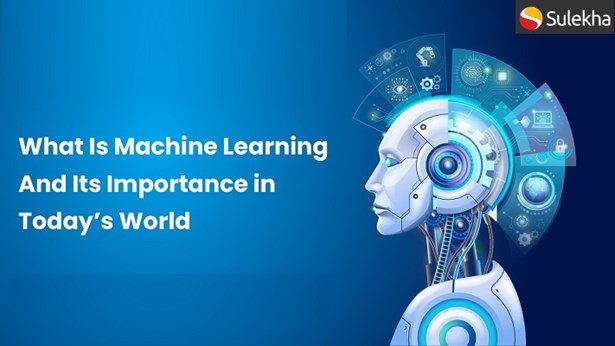What is Machine Learning?

ML is the branch of artificial intelligence creating computer algorithms and models capable of learning from the data without explicit programming. Instead of being explicitly programmed to perform a specific task, these algorithms use patterns and insights from data to improve their performance. Machine learning models may handle complex issues with growing accuracy over time by being trained on massive volumes of data to generate predictions, identify patterns, and solve complex problems. It is utilized in various industries, including image identification, natural language processing, recommendation systems, medical diagnostics, and more.
Machine Learning vs. Deep Learning vs. Neural Networks
These concepts come under artificial intelligence and seem similar, but each has a distinct notion within artificial intelligence (AI). Here's a brief explanation of each:
- Machine Learning (ML): A subset of AI known as "machine learning" focuses on developing statistical models and algorithms that let computers learn from data and improve at any specific activity. Machine learning focuses on discovering patterns and making predictions from the data without being explicitly programmed.
- ML algorithms can be broadly divided into three types: supervised Learning, unsupervised Learning, and reinforcement learning.
- Supervised Learning involves model learning from labeled data, unsupervised Learning involves finding patterns in unlabeled data, and reinforcement learning involves making decisions by interacting with the environment and receiving feedback.
- Deep Learning: Deep Learning is a branch of machine learning that models and solves complicated problems using artificial neural networks. These neural networks made up of interconnected layers of nodes (neurons), are inspired by the structure and function of the human brain. Deep learning algorithms may automatically learn to represent data in these hierarchical layers, with each layer learning more abstract properties from the preceding one. Deep Learning has received much attention and success in tasks like image and speech recognition, natural language processing, etc.
- Neural Networks: Interconnected nodes (neurons) that make up neural networks are arranged in three layers: an input layer, one or more hidden layers, and an output layer. Learning in neural networks entails modifying the weights of each link between neurons to increase the model's performance.
How does machine learning work?
- Data Collection: Gather relevant data representing the problem you want to solve or the task you want the machine to learn.
- Model Selection: Choose an appropriate machine learning model or algorithm based on the nature of the problem and the available data.
- Training: Use the prepared data to train the selected model.
- Deployment: If the model works well, incorporate it into the intended application or system to make predictions or decisions in real-world scenarios.
What are the different Types of Machine Learning
Various machine learning techniques with distinct goals apply to multiple domains. Here are a few basic machine-learning techniques:
Supervised Learning: In supervised Learning, each input has a corresponding output label, and the algorithm is trained on this labeled dataset. Learning an input-output mapping will enable the system to predict previously unobserved data. Some standard algorithms are:
- Linear Regression: The primary goal is to predict a continuous numerical value.
- Logistic Regression: Utilized for jobs that require predicting one of two outcomes in binary classification tasks
- Support Vector Machines (SVM): used for classification and regression issues, mainly when the data cannot be separated linearly.
- Decision Trees and Random Forests: Effective in building hierarchical decision-making systems and performing classification and regression tasks.
- Neural Networks: An effective approach that may be used for various issues, ranging from image and speech recognition to natural language processing.
- Unsupervised Learning: Unsupervised Learning is the search for patterns, structures, or relationships in data without using explicit output labels.
The algorithm is trained on an unlabeled dataset. Some standard algorithms are:
- Clustering: Clustering data elements based on similar metrics.
- Dimensionality Reduction: Techniques like Principal Component Analysis (PCA) and t-distributed Stochastic Neighbor Embedding (t-SNE) reduce the number of features while preserving crucial patterns.
- Generative Adversarial Networks (GANs): Utilized for generating new data samples, such as images or texts
- Semi-Supervised Learning: A hybrid strategy incorporating features of supervised and unsupervised Learning. It uses a smaller amount of labeled data and a larger amount of unlabeled data.
- Reinforcement Learning: Although the algorithm isn't trained on sample data, reinforcement machine learning is a machine learning approach similar to supervised Learning. By making mistakes along the way, this model learns. A specific issue's ideal recommendation or strategy will be developed by reinforcing successful outcomes.
Real-world machine learning use cases
Here are a few everyday instances of machine learning that you might run into:
- Speech recognition: Speech recognition is a technology that converts spoken language into written text or machine-readable commands. For example, we might use voice search on our mobile devices like Siri.
- Customer service: Automated chatbots for customer support are developed using machine learning. These chatbots can respond quickly to frequent consumer questions and issues and handle routine customer inquiries.
- Computer vision: Machine learning is used in computer vision to enable machines to interpret and understand visual data, such as images and videos.
- Automated stock trading: In automated stock trading, machine learning is employed to develop predictive models that analyze historical stock market data and real-time market information.
- Fraud detection: Machine learning makes real-time fraud detection and prevention possible by examining enormous volumes of data and identifying unusual patterns or behaviors that indicate possible fraudulent activity.
Now that you have understood what is machine learning and how it is utilized for multiple purposes. Moreover, machine learning has become a booming technology, and stepping into this field will help us explore broader career opportunities. It is also expected to be a never-daunting career because every top company utilizes it. If you intend to get into such a demanding career, you can join a machine learning course, which will help you understand basic to advanced machine learning concepts.
Find a course provider to learn Machine Learning
Java training | J2EE training | J2EE Jboss training | Apache JMeter trainingTake the next step towards your professional goals in Machine Learning
Don't hesitate to talk with our course advisor right now
Receive a call
Contact NowMake a call
+1-732-338-7323Take our FREE Skill Assessment Test to discover your strengths and earn a certificate upon completion.
Enroll for the next batch
best machine learning course for beginners
- Dec 12 2025
- Online
best machine learning course for beginners
- Dec 15 2025
- Online
best machine learning course for beginners
- Dec 16 2025
- Online
best machine learning course for beginners
- Dec 17 2025
- Online
best machine learning course for beginners
- Dec 18 2025
- Online
Related blogs on Machine Learning to learn more

How Machine Learning Applications Revolutionizes Everyday Technology and Business
Discover the vast range of machine learning applications across industries and learn how machine learning is transforming businesses and revolutionizing the way we live and work.

What is computer vision? A complete Tutorial
Learn about computer vision in this comprehensive tutorial covering image processing, object detection, and more. Explore the fundamentals and applications of computer vision with practical examples and insights.

Top 10 Applications of Machine Learning
Discover the top 10 machine learning applications revolutionizing industries worldwide, from predictive analytics in finance to healthcare diagnosis and recommendation systems in e-commerce.

Data Science and Machine Learning - The future impact in the world of healthcare
Data Science and Machine Learning - The future impact in the world of healthcare

Adidas now allows consumers to design shoes by themselves
Adidas, a world-famous sports brand, is now banking on machine learning technology to understand consumer trends and preferences and incorporate it into its wide-spread supply chain. What this move does is it allows their customers to design the prod
Latest blogs on technology to explore

From Student to AI Pro: What Does Prompt Engineering Entail and How Do You Start?
Explore the growing field of prompt engineering, a vital skill for AI enthusiasts. Learn how to craft optimized prompts for tools like ChatGPT and Gemini, and discover the career opportunities and skills needed to succeed in this fast-evolving indust

How Security Classification Guides Strengthen Data Protection in Modern Cybersecurity
A Security Classification Guide (SCG) defines data protection standards, ensuring sensitive information is handled securely across all levels. By outlining confidentiality, access controls, and declassification procedures, SCGs strengthen cybersecuri

Artificial Intelligence – A Growing Field of Study for Modern Learners
Artificial Intelligence is becoming a top study choice due to high job demand and future scope. This blog explains key subjects, career opportunities, and a simple AI study roadmap to help beginners start learning and build a strong career in the AI

Java in 2026: Why This ‘Old’ Language Is Still Your Golden Ticket to a Tech Career (And Where to Learn It!
Think Java is old news? Think again! 90% of Fortune 500 companies (yes, including Google, Amazon, and Netflix) run on Java (Oracle, 2025). From Android apps to banking systems, Java is the backbone of tech—and Sulekha IT Services is your fast track t

From Student to AI Pro: What Does Prompt Engineering Entail and How Do You Start?
Learn what prompt engineering is, why it matters, and how students and professionals can start mastering AI tools like ChatGPT, Gemini, and Copilot.

Cyber Security in 2025: The Golden Ticket to a Future-Proof Career
Cyber security jobs are growing 35% faster than any other tech field (U.S. Bureau of Labor Statistics, 2024)—and the average salary is $100,000+ per year! In a world where data breaches cost businesses $4.45 million on average (IBM, 2024), cyber secu

SAP SD in 2025: Your Ticket to a High-Flying IT Career
In the fast-paced world of IT and enterprise software, SAP SD (Sales and Distribution) is the secret sauce that keeps businesses running smoothly. Whether it’s managing customer orders, pricing, shipping, or billing, SAP SD is the backbone of sales o

SAP FICO in 2025: Salary, Jobs & How to Get Certified
AP FICO professionals earn $90,000–$130,000/year in the USA and Canada—and demand is skyrocketing! If you’re eyeing a future-proof IT career, SAP FICO (Financial Accounting & Controlling) is your golden ticket. But where do you start? Sulekha IT Serv

Train Like an AI Engineer: The Smartest Career Move You’ll Make This Year!
Why AI Engineering Is the Hottest Skillset Right Now From self-driving cars to chatbots that sound eerily human, Artificial Intelligence is no longer science fiction — it’s the backbone of modern tech. And guess what? Companies across the USA and Can

Confidence Intervals & Hypothesis Tests: The Data Science Path to Generalization
Learn how confidence intervals and hypothesis tests turn sample data into reliable population insights in data science. Understand CLT, p-values, and significance to generalize results, quantify uncertainty, and make evidence-based decisions.